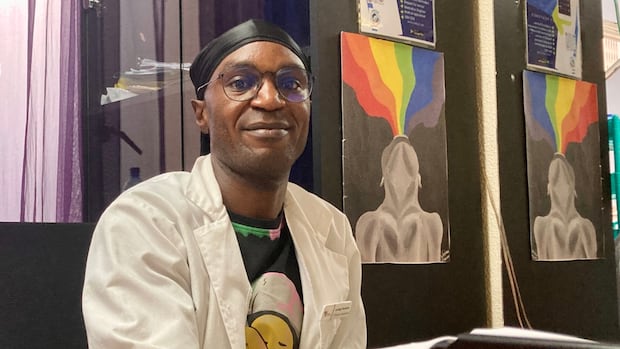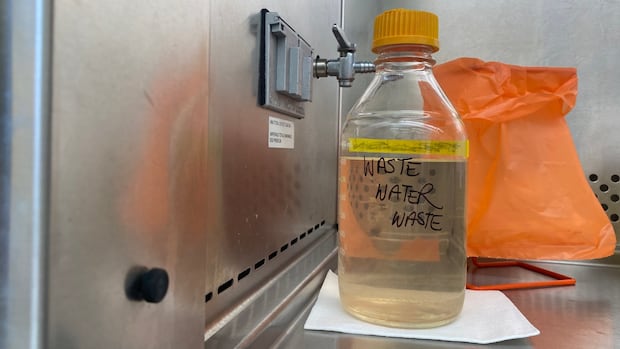In one week, Patrick Cully will find out whether his five-year-old daughter Scarlet will be able to continue the life-changing therapy she’s relied on for more than a year — or if long waitlists and a lack of funding will halt her progress.
On June 23, the Federal Court ordered Indigenous Services Canada (ISC) to issue a decision by July 18 about whether it will continue to fund the therapy for Scarlet, who was diagnosed with Level 2 autism spectrum disorder (ASD).
Scarlet, who lives in Thunder Bay, Ont., with her family, is a member of Batchewana First Nation — an Ojibway community east of Sault Ste.
The three levels of ASD reflect the amount of support a person needs. A diagnosis of Level 2 ASD means Scarlet, who has severe speech delays, has significant challenges in social communication and interaction, and restricted and repetitive behaviours.
But thanks to full-time applied behaviour analysis (ABA) therapy, Scarlet has gone from using an augmented and alternative communication device to being able to speak on her own.
Since ISC denied her family’s request for further funding under Jordan’s Principle, amounting to $217,650, Scarlet’s development plan has been up in the air.
“The family’s hope is that [by] applying the proper scope of Jordan’s Principle, that these supports will be approved and that Scarlet will be able to continue having access to the services that she really needs,” said David Taylor, managing partner at Conway Litigation based in Ottawa, and the family’s legal representative.
Jordan’s Principle was established by the Canadian Human Rights Tribunal to ensure First Nations children don’t face gaps, delays or denials in accessing government services because of their identity.
The principle is based on the legal concept of substantive equality — meaning First Nations children may require additional support to receive the same level of services as other children in the country.
However, multiple families and advocates have expressed concerns about the way Jordan’s Principle applications are being processed, in light of operational and eligibility changes to the program were announced in February. Their argument is the government is using too narrow a scope for funding approvals.
In Scarlet’s case, the government said it was not aware of an existing government service that provides funding for full-time ABA therapy, which means the concept of substantive equality does not apply.
The family’s hope is that [by] applying the proper scope of Jordan’s Principle, that these supports will be approved and that Scarlet will be able to continue having access to the services that she really needs.– David Taylor, Conway Litigation
“Scarlet’s case isn’t the only one I’ve seen this rationale [for],” Taylor said. “I’ve seen it in other denial letters that have come out in the last six or seven months.
“I’ve been practising law in this area for 10, 11 years, and I’ve never seen that rationale coming out of the government before this year.”
Meanwhile, applications are piling up; ISC says it’s dealing with a backlog of about 140,000 cases.
ISC assessing court case
ISC says it’s assessing the Federal Court’s decision on Scarlet’s case “and is not in a position to discuss it at this time,” spokesperson Jennifer Cooper told CBC News in an email on Wednesday.
However, she said, each request “is considered on a case-by-case basis, along with the required documentation for the request, while taking into account the distinct needs and circumstances of the child/children.”

“An existing or previously approved request does not guarantee that a request for new funding will be renewed or approved,” Cooper said. “Our priority is supporting First Nations children’s equal access to the essential government services they need.”
The Cully family went through the ISC’s internal appeal process and Federal Court to challenge the funding decision.
In mid-May, ISC’s appeal committee agreed to provide $24,500 in partial funding plus an additional $16,000, according to court documents obtained by CBC News.

This allows Scarlet to remain in full-time ABA therapy until at least Aug. 1. Then, her spot in the program will be held until Aug. 29, after which she’ll be put on a six- to 18-month waitlist.
Meanwhile, it could take more than five years to get into the Ontario Autism Program, and Scarlet’s family says she can’t afford to wait that long.
“This is really a narrow window where these therapies can help Scarlet have the same standard and quality of living as her peers who don’t have autism,” Taylor said.
Why ABA therapy costs so much
Nicole Neil is a registered, board-certified behaviour analyst and associate dean of research at Western University’s faculty of education.
Her research has shown how ABA therapy can help children with autism and other diagnoses learn a range of meaningful skills, such as communication, emotional regulation, daily living and social interaction.

Scarlet’s ABA therapy includes speech pathology, physiotherapy, occupational therapy and music therapy five times a week. Due to the level of training and supervision needed, as well as the individualized nature of the care plans, behaviour analysts can charge more than $100 an hour for such services, Neil explained.
“For children with autism with intensive support needs, clinical recommendations can be 25 or more hours per week of behaviour analytic services,” she said. “The fees become quite high.”
In a recent survey of families caring for children with autism, Neil found about one-third of them were waiting for services, while those awaiting funding were paying significant out-of-pocket expenses.
“One reason that the care needs to be accessible is to reduce the financial burden on the families,” Neil said. “The other aspect is that we want to support children to be happy, healthy and engaged in their communities.
“When people don’t have access to the care that they need, they aren’t able to engage with their community and learn or participate in school or other programs because there isn’t the support for them to do that.”
Applying for therapy funding ‘onerous for families’
While Jordan’s Principle was created to bridge gaps, the process of applying and reapplying for funding while having to prove one’s child is in need of services “is very onerous for families,” said Nicole Ineese-Nash, an assistant professor in the schools of child and youth care and early childhood studies at Toronto Metropolitan University.
Ineese-Nash, a member of Constance Lake First Nation in Treaty 9, studies the intersection of Indigeneity and disability. She’s also the founder of Finding Our Power Together, a non-profit that supports First Nation youth mental health.

In her view, Jordan’s Principle isn’t addressing the core issue “that children with disabilities require services and should not be met with delays on the basis of funding and who should pay for that service.”
“We’ve created just another infrastructure to kind of pass the buck between governments to seemingly deny service to children.”
Though she sees value in providing funding directly to families, an ongoing challenge is the lack of disability support designed specifically for Indigenous children by First Nations themselves, she said.
“I think ultimately, we as Indigenous people need to think more broadly about how we are supporting our own people. Yes, advocate for government change and advocate for broader systems reform and increased funding for families — and at the same time, think deeply about what it means to build our own structures and our own networks of care.”






